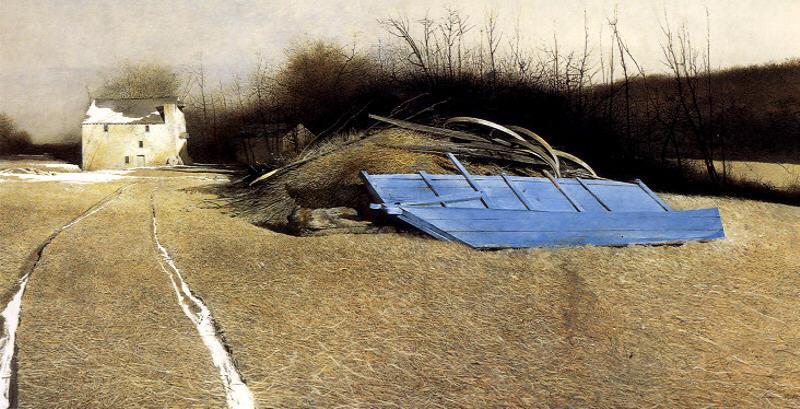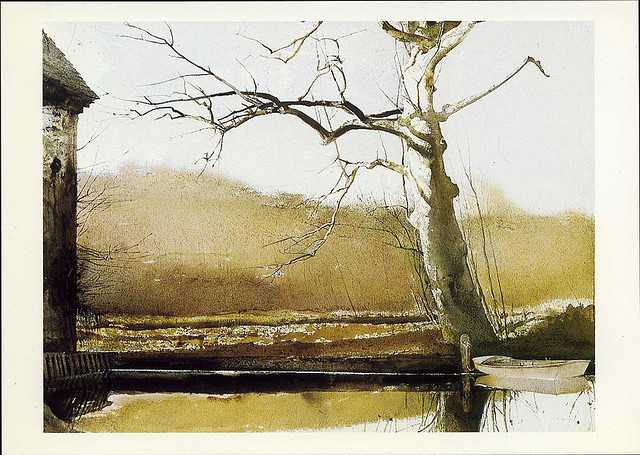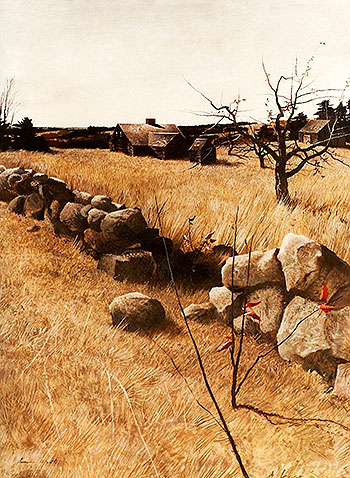These obstinate pioneers all bucked the trend, by painting well in traditional styles. They also made a good living by selling their work because it was beautiful and of high quality.
Andrew Wyeth an American Master Who Shows that Even in the 21st Century Beauty will Sell
 Last week I did a feature on an American artist who lived in the 20th century yet made his name painting in the naturalistic tradition. This week there is another. Andrew Wyeth died just a couple of years ago and lived in Pennsylvania. Like Hopper he would spend his summers in Maine and so his landscapes feature this beautiful coastline as well.
Wyeth is in my opinion a master of the highest quality. Unlike Hopper, he is more traditional in his use colour. Whereas Hopper would paint the whole canvas brightly coloured, Wyeth is is content to leave large areas of the painting muted in colour, rendering them tonally; and then giving more colour and contrast in those areas of primary contrast. He handles this balance masterfully. Many of his paintings are in the medium of in egg tempera - this is the one that icon painters use. This dries very quickly and is difficult to blend. In order to create a blurred effect, Wyeth tends to treat the paint as a crayon in which he blends using multiple strokes that become more dispersed in those areas that he intends to more diffuse. He also paints beautiful watercolours.
Last week I did a feature on an American artist who lived in the 20th century yet made his name painting in the naturalistic tradition. This week there is another. Andrew Wyeth died just a couple of years ago and lived in Pennsylvania. Like Hopper he would spend his summers in Maine and so his landscapes feature this beautiful coastline as well.
Wyeth is in my opinion a master of the highest quality. Unlike Hopper, he is more traditional in his use colour. Whereas Hopper would paint the whole canvas brightly coloured, Wyeth is is content to leave large areas of the painting muted in colour, rendering them tonally; and then giving more colour and contrast in those areas of primary contrast. He handles this balance masterfully. Many of his paintings are in the medium of in egg tempera - this is the one that icon painters use. This dries very quickly and is difficult to blend. In order to create a blurred effect, Wyeth tends to treat the paint as a crayon in which he blends using multiple strokes that become more dispersed in those areas that he intends to more diffuse. He also paints beautiful watercolours.
In painting grass and trees, he tends to supply more detail than Hopper. Part of this is the consequence of using egge tempera in which every stroke is so clearly dilineated. In order to avoid the sense of a painting overloaded with detail, he relies far more on muting the colour and the contrast in comparison to those areas of primary focus. I think it is interesting that despite the fact that so much of his paintings are brown, black and white, we don't feel a sense of a lack of colour, because he knows the crucial focal points in which he must supply it.
The success of Wyeth as a painter - his work was always popular and he was recognised in his lifetime with awards from the American government for achievement - demonstrates to us artists that if we produce work of high enough quality, we can succeed. And if we are not successful...it is most likely because we are not good enough and should aim to get better!











